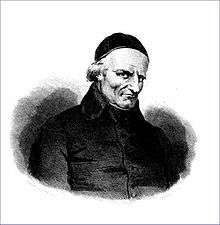Louis-Pierre Anquetil

Louis-Pierre Anquetil (21 February 1723 – 6 September 1808) was a French historian.
Biography
He was born in Paris on 21 February 1723.[1] In 1741, he joined the religious community of the Génofévains, where he took holy orders and became professor of theology and literature.[2] Later, he became rector of the seminary at Reims, where he published the 3-volume "Civil and Political History of Reims" (French: Histoire civile et politique de Reims), in 1756 and 1757.[2] In 1759, he was appointed prior of the abbey de la Roe in Anjou; shortly thereafter he became director of the college of Senlis.[1] While there, he composed a history of France in the 16th and 17th centuries (Esprit de la Ligue, ou histoire politique des troubles de France pendant les XVIe et XVIIe siècles) published in 1767.[2] The year before, he had obtained the curacy or priory of Chateau-Renard near Montargis.[1] He also became a member of the Académie des Inscriptions et Belles-Lettres.[3]
At the beginning of the French Revolution, he moved to the curacy of La Villette near Paris but, during the Reign of Terror, he was imprisoned at St-Lazare.[1] While there, he began his summary of world history (Précis de l'histoire universelle), afterwards published in nine volumes.[2] On the establishment of the National Institute, he was elected as a 2nd-class member of the Academy of Moral and Political Science.[1] He was also employed by the French Ministry of Foreign Affairs,[1] an experience which informed his treatment of the last three kings of the Ancient Regime (Motifs des guerres et des traités de paix sous Louis XIV, Louis XV, Louis XVI).[2]
He is said to have been asked by Napoleon to write his 14-volume "History of France" (Histoire de France, 1805). Augustin Thierry criticized the work as "cold and colourless", and mentioned that Anquetil compared unfavorably to other noted French historians.[4] The work was compiled at second or third hand[2] and censurable in many respects[1] but went through numerous editions and made Anquetil famous. It was continued by Adolphe Bouillet in 6 more volumes.[2] He died on 6 September 1808.[1]
His younger brother Abraham was a famous orientalist.
Notes
References


Attribution:
